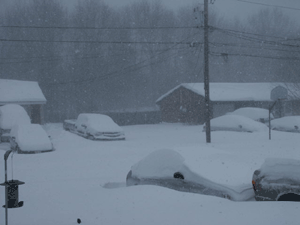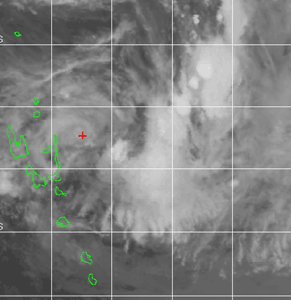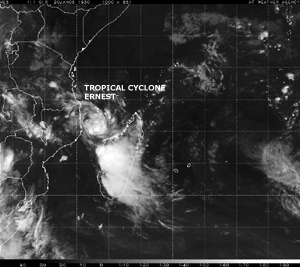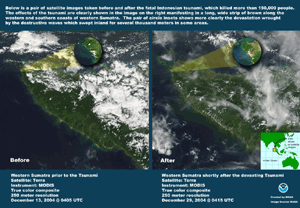

|
January 2005 |

For comprehensive drought analysis, please see the current U.S. drought report.


|
Resulting from the rainfall associated with these Pacific storms, a deadly mudslide near La Conchita, California on January 10 claimed 10 lives. For complete details on the impacts of heavy precipitation throughout the western U.S., see the special storm summary page. |
In Canada, heavy rain produced a mudslide in North Vancouver, British Columbia during the early morning of the 19th. At least one person was killed, and another seriously injured (Reuters). Vancouver received more than 130 mm (5.2 inches) of rain in the three-day period preceding the landslide.
In Saudi Arabia, heavy rains produced some of the worst flooding in 20 years in the city of Medina. The rainfall caused a dam to collapse, isolating many villages and forcing many residents from their homes. Eight people were killed by floodwaters on the 24th (BBC News).
For an archive of flood events worldwide, see the Dartmouth Flood Observatory.


|
In the United States, a line of severe thunderstorms preceding a strong cold front brought wind damage and a few tornadoes to parts of the Deep South and Southeast on the 13th. A tornado in Laurens, South Carolina produced damage to frame structures, and was responsible for igniting a large industrial fire (NOAA/NWS). The tornado was rated as F2 intensity on the Fujita Tornado Scale. |

| Tropical Cyclone Kerry developed in the South Pacific Ocean on January 5. The storm crossed over the northern islands of Vanuatu on the 7th with maximum sustained winds near 65 km/hr (40 mph). Kerry strengthened south of Vanuatu, before finally dissipating over open South Pacific waters on the 12th. | 
|

|
Tropical Cyclone Ernest developed in the Mozambique Channel between Madagascar and the coast of Mozambique on the 20th. The cyclone reached the coast of southern Madagascar on the 23rd, with maximum sustained winds at the time of landfall near 100 km/hr (60 mph). There were at least 17 fatalities, with the southern city of Tulear inundated by severe flooding (Reuters/AFP). |
Tropical Cyclone Raymond developed on January 1 in the Indian Ocean off the coast of Western Australia. Raymond tracked inland over extreme northern Western Australia near Kuri Bay with maximum sustained winds near 85 km/hr (50 mph). Locally heavy rain accompanied the cyclone as it weakened quickly upon landfall on the 3rd.



|
A significant winter storm which brought heavy snowfall to areas of the Intermountain West produced more wintry weather as it moved into the U.S. Great Plains and eventually into the Northeast by the 6th. While a significant ice storm affected areas of Kansas and Missouri, heavy snow fell in areas of Nebraska, Iowa and into northern Illinois. Local snowfall accumulations exceeded 15 cm (6 inches). The snow and ice spread into the Northeast corridor of the United States by the 6th. |

|
A major winter snowstorm, referred to as the "Blizzard of 2005", affected the metropolitan areas of the Northeastern United States during January 22-23. Snowfall accumulations exceeding one foot covered much of southern New England in the storm's aftermath, with well over two feet in some areas of Massachusetts. Strong winds created blizzard conditions with low visibilities and considerable blowing and drifting of snow. By the 27th, month-to-date snowfall at the Boston Logan International Airport totaled 43.1 inches, making January the snowiest month on record. The same storm system deposited heavy accumulations of snow on Halifax, Nova Scotia and much of Atlantic Canada, canceling most flights on the 23rd (Reuters). Additional information on this event may be found on the Northern Hemisphere Snow and Ice page. |
In the United States, a significant ice storm struck parts of northern Georgia on the 30th-31st. Ice accretion was as great as 2 inches in Monroe county, located southeast of Atlanta. Power outages in the area at the height of the storm affected nearly 320,000 homes and businesses (Associated Press).
In Algeria, a winter storm deposited the heaviest snowfall since 1950 on the 27th (Algiers Meteorological Services). The snowstorm paralyzed the capital city of Algiers and more than a third of the country. More than 100 roads were closed, and the severe winter weather was blamed on 13 deaths (Reuters/BBC News). Northward across the Balearic Islands in the western Mediterranean, snow fell for the first time in decades, with 8 cm (3 inches) of snow at Mahon on Menora on the 26th (BBC News).
References:
Basist, A., N.C. Grody, T.C. Peterson and C.N. Williams, 1998: Using the Special Sensor Microwave/Imager to Monitor Land Surface Temperatures, Wetness, and Snow Cover. Journal of Applied Meteorology, 37, 888-911.
Peterson, Thomas C. and Russell S. Vose, 1997: An overview of the Global Historical Climatology Network temperature data base. Bulletin of the American Meteorological Society, 78, 2837-2849.
 NOAA's National Centers for Environmental Information
NOAA's National Centers for Environmental Information









